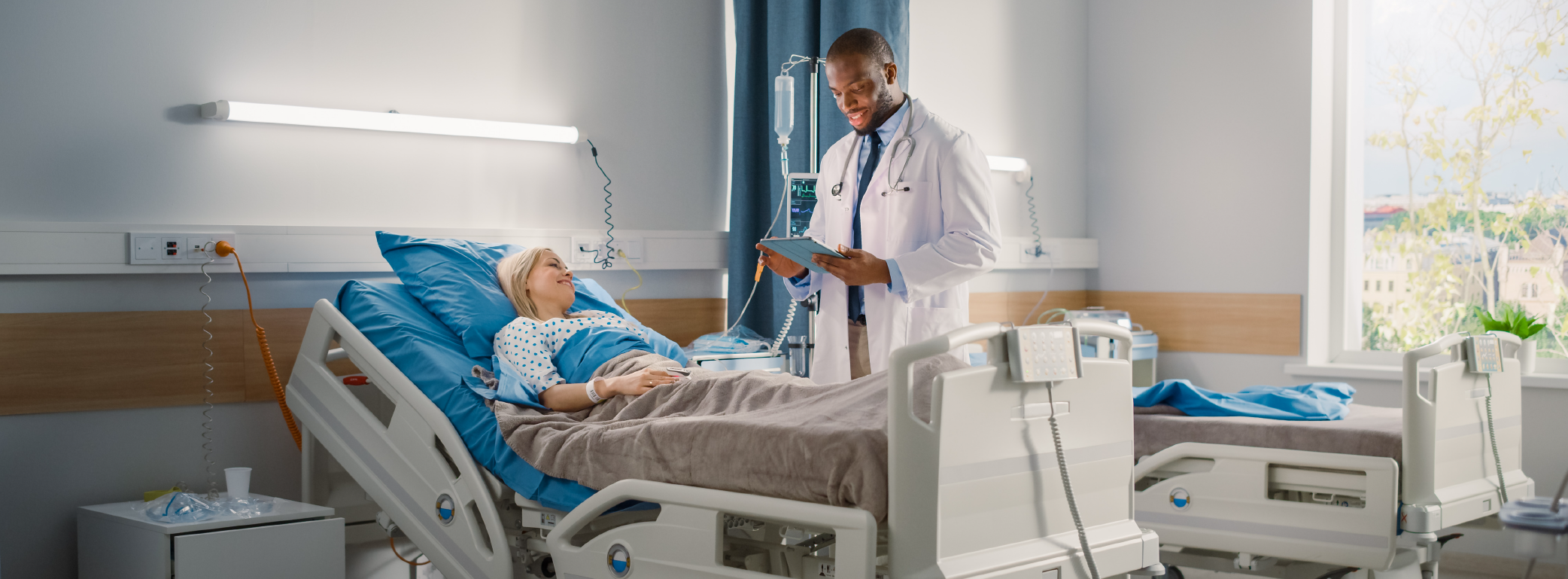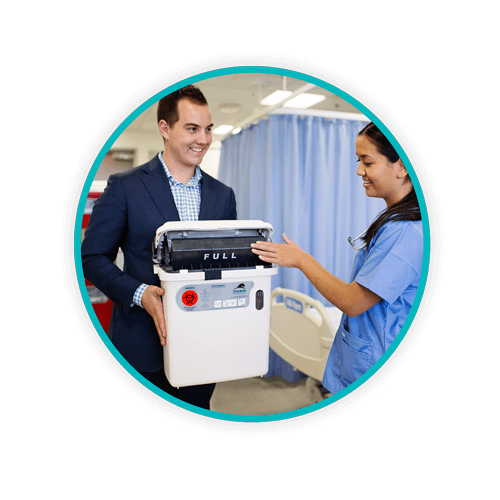Patient Room Cleanup: Removing Biohazardous Waste Safely

Ensuring the safety and compliance of biohazardous waste removal from patient rooms is critical. This guide provides effective methods to manage and dispose of various types of biohazardous waste effectively.
TOPICS WE WILL COVER:
1 / Understanding Biohazardous Waste in Healthcare Settings
2 / Regulations Governing the Disposal of Biomedical Waste
3 / How is Biohazardous Waste Removed From the Patient’s Room?
4 / The Importance of Proper Biomedical Waste Disposal in Hospitals
5 / How to Improve Your Biomedical Waste Disposal Methods
7 / Get Started With Professional Biohazardous Waste Disposal
 Understanding Biohazardous Waste in Healthcare Settings
Understanding Biohazardous Waste in Healthcare Settings
Biohazardous waste comprises any solid waste or liquid waste contaminated with blood, human body fluids, or other materials that could potentially spread infections. This includes any item that has been exposed to potentially infectious agents.
Types of Biohazardous Waste
In the confines of patient rooms, biohazardous waste includes a variety of items critical to patient care, but hazardous if not handled correctly.
Some examples of biohazardous waste include:
- Infectious Waste: Blood, blood products, and other bodily fluids, along with any equipment that becomes contaminated, such as IV tubing and used PPE.
- Clinical Microbiological Waste: Items like cultures or stocks that might contain pathogens, as well as used petri dishes.
- Pathological Waste: Tissues and materials from biopsies or surgeries.
- Sharps: Needles, scalpels, broken vials, and other items that can puncture the skin and are often contaminated.
- Genetic Material: Recombinant DNA and RNA samples used in research and medical testing.
Ensuring that biohazardous waste is correctly removed from patient rooms minimizes the risk of infection and is a critical operation within biomedical waste disposal in hospitals.
Regulations Governing the Disposal of Biomedical Waste
The management and disposal of biomedical waste in the United States is generally regulated by state environmental and health departments. While the Resource Conservation and Recovery Act (RCRA) does establish “cradle-to-grave” obligations for managing hazardous waste, it does not provide regulations for medical or biohazardous waste. Instead, the regulations for medical waste are overseen by various agencies including the Centers for Disease Control (CDC), Occupational Safety and Health Administration (OSHA), and the US Food and Drug Administration (FDA).
Healthcare Facility Obligations
Healthcare facilities, ranging from large hospitals to local clinics and dental offices, bear the primary responsibility for the biohazardous waste they generate. This responsibility includes ensuring proper segregation, labeling, and storage of biohazardous waste within the facility. Facilities must adhere to specific biomedical waste disposal methods that comply with both federal and state regulations. These methods are designed to safely remove biohazardous waste from patient areas and minimize risks to staff and the public.
In order to fulfill protocols for the disposal of biomedical waste, facilities must also ensure that the waste is transported by licensed removal services to approved treatment and disposal facilities.For more detailed information on medical waste regulations and to ensure compliance, healthcare providers should consult their state’s environmental and health departments and the relevant federal agencies’ guidelines.
How is Biohazardous Waste Removed From the Patient’s Room?
So, how is biohazardous waste removed from the patient’s rooms? The process and requirements may vary between sharps and other regulated medical waste:
Sharps Biohazardous Waste
In healthcare settings, managing sharps waste is a critical aspect of overall biohazardous waste control. Sharps, defined as any device that can cut or puncture skin—such as needles, scalpels, lancets, and even broken glass—pose a significant risk not only due to their potential to cause injury but also because they can be contaminated with pathogens.
Use of Puncture-Resistant Containers
To ensure safe removal from patient rooms, all sharps must be disposed of in specially designed containers. These containers are made from materials that are not only puncture-resistant but also leak-proof to prevent exposure to infectious agents. They are also clearly labeled with the universal biohazard symbol and the word “Biohazard” to highlight their contents and ensure correct handling.
Proper Sealing and Labeling
The disposal of biomedical waste involves more than just placing sharps into a container. Once these containers reach three-quarters full, they must be properly sealed and closed. This prevents overfilling, which can lead to accidental needlesticks or other injuries during handling.
After sealing, these containers are then safely removed from the patient’s room by trained specialists or biomedical waste disposal personnel, adhering to biomedical waste disposal methods and regulations.
Regulated Medical Waste (Solids and Liquids)
Regulated Medical Waste (RMW) in healthcare environments includes both solid and liquid forms. Solid RMW consists of items like contaminated gloves, pipettes, and any non-sharp materials that have been exposed to infectious agents. Liquid RMW typically includes blood, bodily fluids, and microbial cultures. Proper handling of these materials is critical to prevent the spread of infections within healthcare settings.
Use of Puncture-Resistant Containers
Like with sharps waste, both types of RMW require containment in sturdy, leak-proof containers to ensure safe removal from patient rooms and prevent environmental contamination. These containers are specifically designed to handle the demands of both solid and liquid waste without leaking or breaking.
Pre-Treatment and Disposal Methods
Before final disposal, it is often necessary to treat RMW to mitigate the risks associated with hazardous materials. Solid wastes may require autoclaving or incineration to neutralize any biohazardous content before being sent to landfill. Liquid wastes are typically treated chemically or mechanically before being safely discharged to sanitary sewer systems.
The Importance of Proper Biomedical Waste Disposal in Hospitals
When biohazardous waste is not correctly managed, it can lead to exposure to infectious agents such as HIV, Hepatitis B, and Hepatitis C. Additionally, it can lead to environmental contamination, which poses further public health risks.
Preventive Measures

To mitigate these risks, it is essential to implement stringent disposal of biomedical waste protocols. This includes ensuring that all biohazardous waste is properly segregated, contained, and labeled. Healthcare workers should be trained in the proper handling and disposal of biohazardous materials.
Regular audits and compliance checks should be conducted to ensure adherence to biomedical waste disposal methods. By following these practices, hospitals can protect their staff and patients from the dangers of biohazardous waste exposure.
How to Improve Your Biomedical Waste Disposal Methods
There are several ways you can improve your biomedical waste disposal methods:
Segregation of Waste
Proper segregation helps ensure that each type of waste is treated and disposed of appropriately, reducing the risk of contamination and exposure. Healthcare workers must be trained to identify various categories of biomedical waste, such as sharps and contaminated PPE.
Proper Handling Techniques
Implementing best practices for handling biohazardous waste is essential to minimize risks in hospitals. For example, healthcare workers should never attempt to recap or manipulate used needles. Instead, they should be placed directly into sharps containers to avoid needlestick injuries.
All biohazardous waste containers should be securely sealed and clearly labeled before removal from the patient’s room. Regular training on the correct biomedical waste disposal methods and the use of PPE can further enhance safety.
Daniels Health Solutions
Daniels Health provides advanced biohazard waste containers designed for safe and compliant biomedical waste disposal in hospitals. Features like leak-proof construction, tamper-proof seals, and odor-lock technology ensure secure containment and a pleasant work environment. Our reusable bins reduce the need for single-use plastics, promoting sustainability.
Enhanced Safety and Efficiency

Our biomedical waste disposal services include collection, transportation, and treatment using Bondtech full vacuum steam autoclaves, ensuring thorough sterilization at 285°F and 30 psi pressure. This process reduces contamination and infection risks, enhancing safety and efficiency in biomedical waste management.
Compliance Assurance
Daniels Health helps healthcare facilities meet regulatory requirements and maintain high safety standards. Partnering with us ensures responsible and compliant biohazardous waste disposal.
Get Started With Professional Biohazardous Waste Disposal
Effective biohazardous waste management is crucial for ensuring safety in healthcare settings. Proper disposal techniques and compliance with regulations are essential to protect staff and patients from exposure to hazardous materials. Understanding how biohazardous waste is removed from the patient’s room and employing compliant biomedical waste disposal methods is vital in hospitals to prevent contamination and infection. Contact us today to upgrade your facility with the highest standards of safety and compliance for biohazardous waste disposal.
Let's Talk!
Your time is valuable, and we don’t want to play hard to get. You can either phone us directly on the details listed on our contact page, or feel free to fill out this short form and one of our team members will get back to you as quickly as possible.
